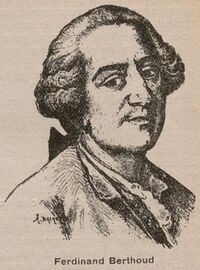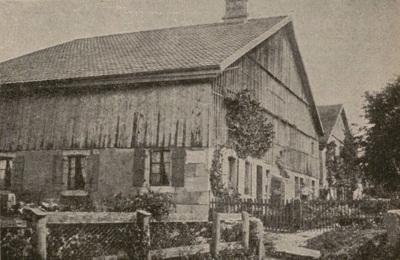Ferdinand Berthoud: Difference between revisions
No edit summary |
No edit summary |
||
| (One intermediate revision by the same user not shown) | |||
| Line 2: | Line 2: | ||
[[File:AdH 1904 19-094 Ferdinand Berthoud.jpg|right|200px]] | [[File:AdH 1904 19-094 Ferdinand Berthoud.jpg|right|200px]] | ||
'''La Chronométrie Ferdinand Berthoud''' is a watch brand of [[Chopard Group]], announced in [[2013]] and named for 18th century clockmaking pioneer [[Berthoud, Ferdinand|Ferdinand Berthoud]]. | '''La Chronométrie Ferdinand Berthoud''' is a watch brand of [[Chopard Group]], announced in [[2013]] and named for 18th century clockmaking pioneer [[Berthoud, Ferdinand|Ferdinand Berthoud]]. | ||
Ferdinand Berthoud, born on March 18, [[1727]], in Plancemont sur Couvet, Neuchâtel, Switzerland, and his nephew [[Louis Berthoud]] have left an indelible mark on the world of horology. Both individuals, through their dedication to precision timekeeping and innovative contributions, have earned a lasting place in the history of watchmaking. | |||
==Ferdinand Berthoud== | |||
[[File:AdH 1904 19-094 Couvet Berthoud.png|thumb|400px|left|Ferdinand Berthoud's birthplace in Couvet]] | |||
Ferdinand Berthoud's early life took an unexpected turn from his father's intended ecclesiastical path when, at the age of 16, he encountered the intricate mechanisms of a clock. This encounter ignited a passion for the mechanical arts, leading him to dedicate his life to horology. Despite initial challenges in Paris, where he exercised his talent clandestinely due to not being part of the watchmakers' corporation, Ferdinand quickly rose to prominence. | |||
His establishment, patronized by influential figures, gained swift recognition for the precision of its products. Departing from simple watchmaking, Ferdinand focused exclusively on pure chronometry. His marine watches, initiated in [[1754]], underwent rigorous sea trials under French government supervision, solidifying his reputation as a master horologist. | |||
Ferdinand Berthoud's contributions extended beyond craftsmanship. In around fifteen volumes, sponsored by the State, he documented valuable observations and discoveries. His notable works include the "History of Time Measurement," the "Treatise on Marine Clocks," and the "Essay on Watchmaking." Despite occasional errors, these works remain relevant and influential. | |||
In [[1768]], Ferdinand presented a groundbreaking theory on the hairspring to the Academy of Sciences, demonstrating its role in achieving isochronous oscillations. This discovery led to the development of exceptionally accurate chronometers for the navy. His theories on regulating balance, friction of pivots, and compensation methods further enhanced the field. | |||
His inventive spirit gave rise to ingenious instruments such as the pyrometer for testing compound pendulums and the elastic balance. Notably, his method of suspending the balance of marine clocks with a flexible spring minimized friction, showcasing his commitment to both theory and practical application. | |||
Ferdinand Berthoud's accomplishments extended beyond horology; he served as a watchmaker to the Navy, a member of the Institute, a member of the Royal Society of London, a knight of the Legion of Honor, and president of industrial exhibition juries. Despite leading a solitary life, his moral austerity, beneficence, and charity earned him widespread respect. Ferdinand Berthoud passed away on June 20, [[1807]], at the age of 80, in Groslay near Montmorency. | |||
==Louis Berthoud== | |||
Louis Berthoud, the nephew and student of Ferdinand, continued the family legacy. While maintaining modesty and solitude, Louis's talent rivaled his uncle's, earning him recognition among the best watchmakers of his time. | |||
Louis focused on refining the caliber of chronometers, successfully reducing their size and improving their arrangement. His approximately 150 chronometers set a new standard for perfection in workmanship and accuracy. As a member of the Institute and watchmaker to the Navy, Louis Berthoud continued the tradition of excellence. | |||
Louis Berthoud passed away in Argenteuil in [[1813]], leaving behind a legacy that complemented and enriched the pioneering contributions of his uncle Ferdinand. Together, Ferdinand and Louis Berthoud stand as exemplars of Neuchâtel's artistic and scientific prowess, their innovations continuing to inspire horologists and scholars to this day. | |||
==History== | ==History== | ||
| Line 8: | Line 33: | ||
The first product launched, [[Ferdinand Berthoud FB 1]], has an octagonal case with the hour and minute hands moved to a subdial at 12:00 to focus on the central seconds hand, driven by a minute [[tourbillon]]. The brand won the “Aiguille d’Or” Grand Prix at the [[Grand Prix d'Horlogerie de Genève]] for this watch in November, [[2016]]. | The first product launched, [[Ferdinand Berthoud FB 1]], has an octagonal case with the hour and minute hands moved to a subdial at 12:00 to focus on the central seconds hand, driven by a minute [[tourbillon]]. The brand won the “Aiguille d’Or” Grand Prix at the [[Grand Prix d'Horlogerie de Genève]] for this watch in November, [[2016]]. | ||
[[Category:Watch brands]] | [[Category:Watch brands]] | ||
[[Category:Manufacturers F]] | [[Category:Manufacturers F]] | ||
[[Category:Watch brands Switzerland]] | [[Category:Watch brands Switzerland]] | ||
[[Category:FHH]] | [[Category:FHH]] | ||
Latest revision as of 22:01, 3 January 2024
- See Also Berthoud, Ferdinand

La Chronométrie Ferdinand Berthoud is a watch brand of Chopard Group, announced in 2013 and named for 18th century clockmaking pioneer Ferdinand Berthoud.
Ferdinand Berthoud, born on March 18, 1727, in Plancemont sur Couvet, Neuchâtel, Switzerland, and his nephew Louis Berthoud have left an indelible mark on the world of horology. Both individuals, through their dedication to precision timekeeping and innovative contributions, have earned a lasting place in the history of watchmaking.
Ferdinand Berthoud

Ferdinand Berthoud's early life took an unexpected turn from his father's intended ecclesiastical path when, at the age of 16, he encountered the intricate mechanisms of a clock. This encounter ignited a passion for the mechanical arts, leading him to dedicate his life to horology. Despite initial challenges in Paris, where he exercised his talent clandestinely due to not being part of the watchmakers' corporation, Ferdinand quickly rose to prominence.
His establishment, patronized by influential figures, gained swift recognition for the precision of its products. Departing from simple watchmaking, Ferdinand focused exclusively on pure chronometry. His marine watches, initiated in 1754, underwent rigorous sea trials under French government supervision, solidifying his reputation as a master horologist.
Ferdinand Berthoud's contributions extended beyond craftsmanship. In around fifteen volumes, sponsored by the State, he documented valuable observations and discoveries. His notable works include the "History of Time Measurement," the "Treatise on Marine Clocks," and the "Essay on Watchmaking." Despite occasional errors, these works remain relevant and influential.
In 1768, Ferdinand presented a groundbreaking theory on the hairspring to the Academy of Sciences, demonstrating its role in achieving isochronous oscillations. This discovery led to the development of exceptionally accurate chronometers for the navy. His theories on regulating balance, friction of pivots, and compensation methods further enhanced the field.
His inventive spirit gave rise to ingenious instruments such as the pyrometer for testing compound pendulums and the elastic balance. Notably, his method of suspending the balance of marine clocks with a flexible spring minimized friction, showcasing his commitment to both theory and practical application.
Ferdinand Berthoud's accomplishments extended beyond horology; he served as a watchmaker to the Navy, a member of the Institute, a member of the Royal Society of London, a knight of the Legion of Honor, and president of industrial exhibition juries. Despite leading a solitary life, his moral austerity, beneficence, and charity earned him widespread respect. Ferdinand Berthoud passed away on June 20, 1807, at the age of 80, in Groslay near Montmorency.
Louis Berthoud
Louis Berthoud, the nephew and student of Ferdinand, continued the family legacy. While maintaining modesty and solitude, Louis's talent rivaled his uncle's, earning him recognition among the best watchmakers of his time.
Louis focused on refining the caliber of chronometers, successfully reducing their size and improving their arrangement. His approximately 150 chronometers set a new standard for perfection in workmanship and accuracy. As a member of the Institute and watchmaker to the Navy, Louis Berthoud continued the tradition of excellence.
Louis Berthoud passed away in Argenteuil in 1813, leaving behind a legacy that complemented and enriched the pioneering contributions of his uncle Ferdinand. Together, Ferdinand and Louis Berthoud stand as exemplars of Neuchâtel's artistic and scientific prowess, their innovations continuing to inspire horologists and scholars to this day.
History
In 2013, Chopard co-presidents Karl-Friedrich Scheufele and Caroline Scheufele announced their intention to create a new high-end watchmaking brand named for Ferdinand Berthoud, pioneer of the marine chronometer. The first products of this participation appeared in 2013 and the brand has proved successful since then.
The first product launched, Ferdinand Berthoud FB 1, has an octagonal case with the hour and minute hands moved to a subdial at 12:00 to focus on the central seconds hand, driven by a minute tourbillon. The brand won the “Aiguille d’Or” Grand Prix at the Grand Prix d'Horlogerie de Genève for this watch in November, 2016.